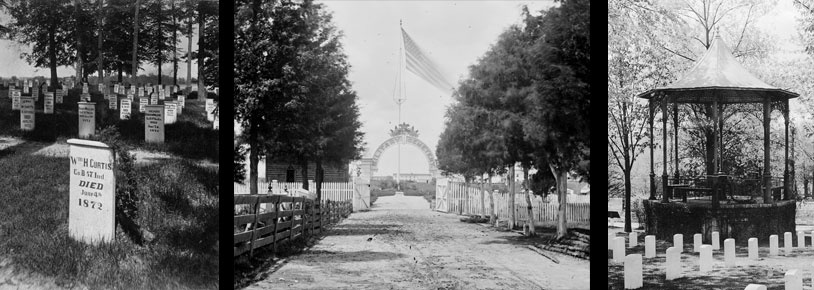

Civil War Era National Cemeteries: Honoring Those Who Served
Fort Harrison National Cemetery
Richmond, Virginia
 |
Superintendent’s lodge and main entrance gates
Courtesy of the Department of Veterans Affairs, National Cemetery Administration, History Program |
After the Battle of Cold Harbor northeast of Richmond, Union General Ulysses S. Grant shifted his troops to the south in order to cut off the Confederate Army, led by General Robert E. Lee. During a series of engagements known as the Battle of New Market Heights on September 29, 1864, Grant ordered a surprise attack of Fort Harrison. The fort, one of a string of forts along the James River to the south of Richmond, was well fortified, but defended by only 200 men. Union troops under General George Stennard took control of the fort, and repelled a Confederate counterattack the next day. Renaming the fort after Union General Hiram Burnham, a casualty at nearby Chaffin’s Farm, the Union held the post until the evacuation of Richmond in April 1865.
To provide a burial place for the Union dead from the assault on Fort Harrison, and some 40 other sites within a five-mile area, the Federal Government established Fort Harrison National Cemetery in May 1866. The cemetery is rectangular in shape, encompassing 1.6 acres, and is enclosed by a four-foot tall brick wall. Two iron pedestrian gates mark the main entrance, which is located along the eastern edge of the grounds.
The cemetery is divided into six burial sections, with a flagpole located in the center of the grounds. Near the main entrance is the Second Empire-styles lodge, built in 1871 according to the standardized plan of Quartermaster General Montgomery C. Meigs. Between the lodge and the flagpole is an artillery monument—an upright canon with a cannonball set in the mouth of the barrel.
Over 1,500 remains are interred in the cemetery, nearly 600 of whom are unknown Union soldiers. There are also a large number of African American soldiers who served with the U.S. Colored Troops in the Battle of New Market Heights buried in the cemetery. Four Confederate soldiers, captured during the battle, are buried here as well. The cemetery closed to new interments in March 1967.
Fort Harrison National Cemetery is the final resting place for a recipient of the Medal of Honor, the nation’s highest military decoration, given for “conspicuous gallantry and intrepidity at the risk of his life above and beyond the call of duty.”
| Plan your visit |
Fort Harrison National Cemetery is located at 8620 Varina Rd., in Richmond, VA. The cemetery is open for visitation daily from dawn to dusk. Limited cemetery staff are present onsite. The administrative office is located at the Hampton National Cemetery. The office is open Monday to Friday from 8:00am to 4:30pm, and is closed on all Federal holidays except for Memorial Day and Veterans Day. For more information, please contact the cemetery office at 757-723-7104, or see the Department of Veterans Affairs website. While visiting, please be mindful that our national cemeteries are hallowed ground. Be respectful to all of our nation’s fallen soldiers and their families. Additional cemetery policies may be posted on site. Fort Harrison National Cemetery is one of seven national cemeteries in the Richmond area. The others include: Glendale and Richmond National Cemeteries in Richmond; Seven Pines National Cemetery in Sandston; Cold Harbor National Cemetery in Mechanicsville; City Point National Cemetery in Hopewell; and Poplar Grove National Cemetery in Petersburg. Richmond National Battlefield Park, a unit of the National Park Service, preserves several battlefields and historic sites related to the 1862 Peninsula Campaign and the 1864 Overland Campaign in and around the former Confederate capital. Fort Harrison National Cemetery was photographed to the standards established by the National Park Service’s Historic American Landscapes Survey. |